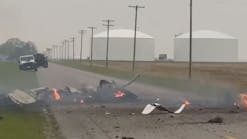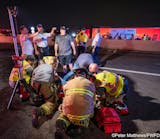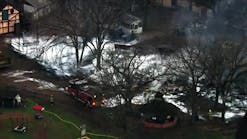Concerns Mount as Minneapolis FD Ranks Diminish
By Christina Saint Louis
Source Star Tribune
When Capt. Cory Martin clocks in for his 24-hour shift at the Minneapolis Fire Department's Station 6 every other day, he expects it to be scattered with flashing fluorescent lights and tonal alarms, the programmed system that alerts firefighters of a call for service.
Located in Stevens Square, Station 6 is Minneapolis' busiest, with an engine that responded to nearly 6,000 calls last year. There, firefighters often sleep in uniform to be ready for calls throughout the night, Martin said.
"Dinner, any sort of thing, we know that we're going to get interrupted," he said. "No one really expects to complete anything without getting up and going on a run."
Calls to Station 6 have steadily increased over the past decade, with demands on the Fire Department outpacing the city's population growth.
Minneapolis' population increased by 12%, according to the most recent census data, while the overall demand on the Fire Department increased by 36%. The department went from responding to 33,601 calls in 2010 to 45,835 in 2020, according to MFD annual reports. The year before, the department responded to 49,602 calls.
But despite the high call volume — and the workload associated with it due to the COVID-19 pandemic — the number of firefighters in the city's ranks dropped after the city offered a retirement incentive last year. For rank-and-file firefighters answering calls day and night, the shorthanded staffing is cause for concern.
Through it all, the number of sworn firefighters has hovered around 400, which means MFD's engines are typically staffed with three firefighters rather than the National Fire Protection Association recommended four. The department aims for a daily staffing of at least 102 firefighters, but that goal was strained by the pandemic causing some of the remaining firefighters to take time away for virus-related isolation or leave. The exact number of how many had to do so was not immediately available.
As of last week, MFD's staff is exactly 400 — the smallest it's been since 2013, based on annual reports.
Fire Chief Bryan Turner said the number of firefighters is currently 19 below its authorized number, mainly because the department was unable to hold Cadet School in 2020 and 2021 because of COVID-19 restrictions.
As a result, the department is off schedule in its normal hiring process, he said.
"The department is currently in the process of putting together a new Civil Service list with the intention of hiring back to our authorized strength and conducting a Cadet School in February," he said.
Newly hired cadets go through three to four months of training before they become city firefighters. That means a February class would not join stations until next May at the earliest.
While the Minneapolis Police Department was recently court-ordered to reach a minimum staffing level of 730 officers by next summer due to population increase and directives in the city charter, the Fire Department was not held to the same standard.
The charter is clear in stating that the City Council must fund a "a police force of at least 0.0017 employees per resident." The section for fire service, however, is vague. " The City Council must fund a fire department that can maintain adequate staffing," it says.
"We are not adequately staffed," said Mark Lakosky, president of the Local 82 firefighters' union about MFD. "The citizens think it's all great, we do a great job — and our members do — but [citizens] don't know we could do better. We could be faster."
Nothing about the actual job responsibilities gets adjusted when there are fewer people on a shift, Lakosky said. The equipment is just as heavy, the expectations when responding to a call are the same and the hose length doesn't change.
"Everything we do doesn't get easier because you give us less people," he said. "It actually gets a lot more intense and a lot more taxing, physically, on firefighters."
In addition to fires, engines respond to a range of rescue and medical emergencies. The firefighters may be called in to lift someone who is unable to move independently, scrub blood off pavement after a violent crime, or contain a natural gas leak, among other things.
One area of improvement Lakosky points to is the amount of time it takes firefighters to respond to calls. The National Fire Protection Association standard is that engines arrive at a given scene within four minutes 90% of the time. MFD has failed to reach that standard for at least the past sixteen years.
Arriving within four minutes 90% of the time is a minimum percentage, said Curt Floyd, a safety tech lead with NFPA. The hope is that departments can beat it, he said.
Still, Floyd recognizes that firefighters can face challenges when trying to arrive in that time frame, like already being out on another assignment, for example. "There are other things that they're doing in the course of their day, and we never know when the call is going to come."
That's why NFPA's standard is 90% of the time, not 100. The 2020 annual report shows that last year, stretched by the pandemic, MFD responded to fire and emergency medical service calls in "five minutes or less" only 70% of the time, the lowest in years.
And then there's the issue of firefighter safety. Between 2019 and 2020, firefighter injuries jumped from 131 to 161. Station 6 alone has seen several injuries: a firefighter who injured his rotator cuff, another who blew out a knee and one who tore his Achilles' tendon.
Three firefighters to an engine hasn't always been MFD's approach. Station 6 Chief Staffan Swanson recalled that most stations had engines staffed with four firefighters when he joined the Fire Department 30 years ago.
"Some of the slower, outlying areas had three, but certainly, all the downtown stations had four," he said. So did Station 7, Station 5, Station 8, and everything on the North Side, Swanson said.
But as the department's budgetary constraints tightened, that changed. Most recently, after the city instituted a hiring freeze and offered early retirement incentives to cut costs during the pandemic, the Fire Department has leaned into overtime to fill shifts. As a result, Mayor Jacob Frey's proposed budget for 2022 allots an increase in MFD's noncontractual overtime budget.
Tyner said he is working with Frey to find a solution to the department's staff size.
"I am pursuing additional personnel above our current authorized strength to increase efficiency, spread out run volume in the downtown area and reduce overtime expenditures," he said. Ultimately, "though we do staff four on the engines when the staffing is available, there is no plan to do that on a daily basis in the foreseeable future."
©2021 StarTribune. Visit startribune.com. Distributed by Tribune Content Agency, LLC.






